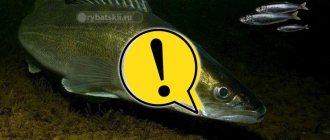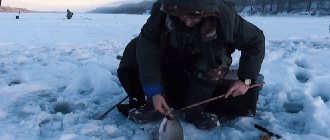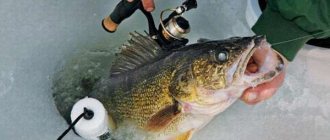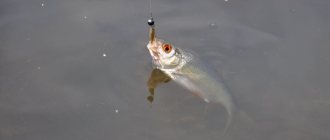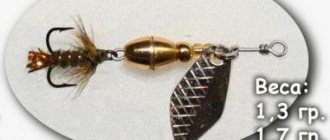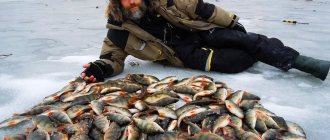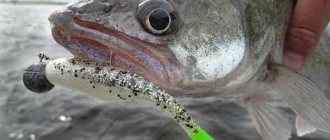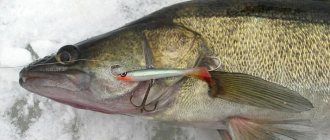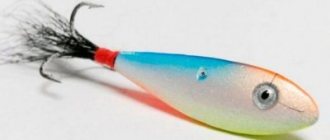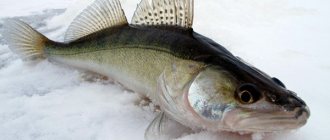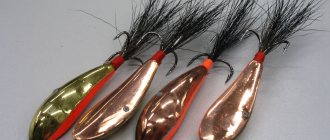Perch activity at different times
If in spring and autumn perch is active almost all day, then with the onset of summer its activity noticeably decreases, and it appears only in the early morning or evening, after the sun sets. This is due to the fact that perch, like any other fish, during the day, in the sunshine, tries to hide from the midday sun. Most often at this time he stands in thickets of grass or in deep holes, hiding in snags. During the day and evening, when the sun no longer warms up the upper layers of the water so much, the perch goes out to hunt; in addition, at this time a massive flight of insects begins, which attract huge flocks of bleaks, which serve as the main food for the perch. It is best to catch perch at this time using spinning tackle.
Most often, small rotating or oscillating spoons are used to catch perch in the summer; in addition, lately fishing with a so-called retractable leash has become increasingly popular. To successfully fish with these baits, it is necessary to choose the right tackle that will allow the fisherman to simultaneously cast a compact and light bait far, and also ideally control the process of retrieving the spoon and landing fish.
Secrets of catching pike perch in winter
Consider tips for catching pike perch in winter:
- Silicone baits. Such baits attract the attention of a predator. Silicone baits should be used in dense snags.
- Winter fishing for pike perch using balance beams. To catch fish in winter, you need to use medium-sized balancers (from 5 to 12 cm). It is necessary to catch pike perch in the bottom layers of water.
- Fishing technique. Professional fishermen use a special technique to activate the bite. First, the bait must be lowered to the bottom. After this, the bait must be lifted smoothly. And after a pause, the bait must be dropped sharply. Using this technique activates the pike perch’s bite.
- Weather. It is necessary to catch pike perch in the evening and morning dawns.
Catching large pike perch in winter
Pike perch is a cunning and curious fish. The best time to fish is during the first ice.
First you need to prepare your winter gear:
- Lures. You need to use big baits.
- Coil. Inertial reels are suitable for catching large pike perch.
- Fishing rod 50–70 centimeters long.
- Fishing line. You need to use thick fishing line.
Large pike perch, leads an isolated lifestyle.
Habitats:
- deep areas;
- channel dumps;
- shallow water areas;
- channel pits.
It is necessary to catch large pike perch in the twilight hours and at night.
Winter pike perch fishing on the Volga
The Volga is one of the largest rivers in Russia. It is the central waterway of the country. The river is home to various species of fish, including pike perch.
The Volga allows every fisherman to try his hand at fighting trophy fish.
The best places to catch pike perch:
- braids;
- overgrown with grass irrigation;
- shallow watering;
- dumps.
The best time to catch pike perch is the end of winter.
Fishing for pike perch in winter from ice
To catch pike perch from the ice in winter, you need to use the following winter gear:
- Braided cord or fishing line. Of course, it is better to use fishing line (0.2–0.3 mm).
- Coil. The reel should move easily.
- Nod. If necessary, the nod can be made from a plate.
- Rod. The length of the rod should be 0.4–1 m.
Catching pike perch from ice requires special safety measures. You need to go fishing when the ice becomes thick and strong.
Choosing a place to catch pike perch using a spoon from ice
To catch fish you need to know the behavior and habitat of pike perch. Pike perch loves depth, heterogeneous terrain, and clean water.
Let's look at the typical habitats of pike perch:
- flooded snag;
- pits;
- flooded riverbeds;
- snags;
- whirlpools;
- piles;
- riffles;
- channel pits;
- eyebrows.
Pike perch lives in reservoirs, rivers, and flowing lakes.
To catch pike perch, you can use various winter gear and bait. Winter gear consists of the following components: rod, reel, fishing line, nod, bait, etc. The best time for fishing is morning and evening dawns.
Which rod to choose
To catch summer perch, it is best to use an ultralight rod up to 2.4 meters long, since with such a spinning rod you can easily cast a small spinner at a distance of up to 40 meters; of course, this is only possible when using thin braided fishing line. If fishing conditions do not allow the use of a rod of this length, then you can use a more compact “stick” 2.1 meters long. It goes without saying that the casting range will decrease, but you will have more room for maneuver, which is very important when fishing in bushes and on heavily overgrown banks. From the name of the spinning rod it is clear that its test weight can hardly exceed 10 grams, and more is not needed, since the weight of a spinner for catching perch can rarely exceed 7 to 8 grams. Moreover, more often you have to fish with 2-3 gram baits, for fishing with which you can use an even lighter spinning rod, with a weight of 0 to 6 grams. For catching perch, it is better to choose a spinning rod with a medium action - such a rod will soften the jerks of the fish well, not allowing it to escape, and besides, the medium action, unlike the slow one, guarantees a more or less reliable hooking. By the way, in some cases, when a perch bites, it is better not to hook at all, since the fish is caught on its own due to a powerful throw on the bait.
Monofilament fishing line for ice fishing
Monofilament fishing line is a synthetic thread made from polyethylene, nylon and other polymer materials. It is used by almost all fishermen, including those who actively fish in winter.
- Monofilament fishing line for winter fishing is especially good for catching predatory fish, because it has a number of really important advantages:
- It has camouflage properties and is available in various colors, this is necessary in order not to stand out against the background of the bottom of the reservoir;
- Cushioning of the fishing line - that is, its ability to stretch well, which allows the fisherman to successfully hook and fish out fish;
- The coefficient of friction is quite low - this means that the line will easily pass through the guide rings and be cast well over long distances;
- Low resistance - that is, the fish bait will be carried well to the desired depth;
- There is a fluorescent type of fishing line - this allows the fisherman to control the behavior of the fish while fishing;
- Low price is another important criterion when choosing this gear.
Monofilament thread is divided into several types:
- MonoFilament is a fishing line with reduced rigidity; it is prone to rapid abrasion, which indicates its fragility;
- Copolymer – this thread is characterized by higher strength, increased rigidity and fairly low memory;
- High-copolymer - such a fishing line is almost invisible in water, as it has a fairly low refractive index, in addition, it is made from modern polymer materials;
- Fluorocarbon is a fishing line with the most controversial assessments: on the one hand, such threads are quite rigid and have poor tension, but on the other hand, they are transparent, quickly submerge in water, and are not afraid of abrasion and low temperatures.
To choose the right monofilament, you need to remember the following criteria:
- The diameter of such a fishing line should be no more than 0.14 mm, on average - 0.06 mm;
- Load on the thread - the choice here is purely individual. As a rule, this indicator is always clearly indicated on the packaging, for example, from 5 kg to 7 kg;
- Thread tension criteria - this figure is also indicated on the packaging, and the higher it is, the better the fishing line is tensioned. But it is worth remembering that unknown manufacturers producing suspiciously cheap equipment simply stretch it to the required thickness, without working on its elasticity;
- Thread memory is a difficult indicator to accurately determine, since it is not indicated on the packaging, so only the direct experience of the fisherman is needed here. It is best when the fishing line has low memory, that is, it does not remember its position in the rolled state. Otherwise, in the unwound state, it will maintain a wave-like shape, constantly attracting the float to the shore;
- Thread stiffness is an indicator that determines the strength of the fishing line and its ability to resist damage from ice and in contact with other parts of fishing gear. Each manufacturer has its own criteria for determining hardness;
- Hydrophobicity of the thread - that is, its interaction with water. An ideal fishing line for winter fishing will not be afraid of water at all, but the hydrophobicity of each manufacturer must be checked through personal experience, since this criterion is also not indicated on the packaging. A low-quality fishing line will allow liquid into its micropores, which will freeze in the cold and thereby destroy the structure of the thread;
- Heat resistance of the thread - here we mean not only frost resistance, but also the perception of sunlight, and warm weather in general. One thing is worth saying here: any winter fishing line does not tolerate ultraviolet light, so it is advisable to store it in a dark place;
- Transparency of the thread - of course, for fishing it is best to choose a more transparent line that will be invisible to the fish. Here, the best option would be a fluorocarbon fishing line, and any manufacturer that produces high-quality equipment must indicate the refractive index in the pond on the packaging.
Spinning reelsSelection of equipment for the feeder
Fishing secrets: catching carp with a spring
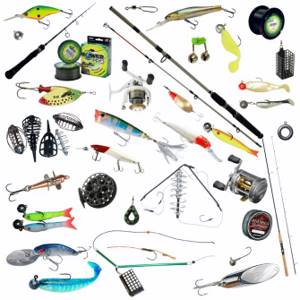
When choosing good equipment for fishing in the winter season, you need to know about manufacturers that produce quality products, for example, Japanese fishing line for winter fishing is very popular:
- Momoi Pro Max Prestige - this manufacturer produces excellent quality fishing line, distinguished by its strength, elasticity and compliance with all declared parameters. The line will remain flexible and strong even at very low temperatures, and is by far the most recommended product based on customer reviews;
- Salmo Grand Ice Magic is a slightly less well-known company, but produces no less high-quality fishing line. It has been tested by many fishermen; it also has high strength at various nodes and elasticity in severe frost;
Japanese fishing line for winter fishing is also produced by other manufacturers, for example, Sufix Invisiline Clear, whose product always 100% corresponds to the quality stated on the packaging. It is also worth paying attention to the company Tiagra, which produces excellent fishing line, ideal for leashes, or Ion power, a manufacturer specializing in the production of sports equipment. The fishing line of this company is very resistant to any damage during fishing, and when immersed in water it becomes transparent, which increases the possibility of a good catch.
Choosing a reel for perch fishing
A reel for catching perch in the summer must be of high quality, since you will have to “work” with very thin braided lines, and only a high-quality reel equipped with a worm gear can ensure high-quality winding of the line. Otherwise, when fishing with light baits, the thin cord will not be wound evenly onto the spool, with lumps that can lead to the formation of beards and loops, which are very difficult to untangle on a thin braid. Therefore, in this situation, it is better not to save money, but to immediately purchase, albeit not very cheap, but a reliable and high-quality reel. As for the size of the reel, I think everyone understands that on an ultralight fishing rod it is necessary to install a reel no larger than 1.5 thousand in size. In rare, very rare cases, it is acceptable to use a 2 thousand size reel if your rod has a more powerful test and a length greater than 2.4 meters. Most often, when fishing for perch on an ultralight spinning rod, I use a 1.5 thousand reel.
Which fishing line to choose for perch
As I said above, for catching perch in the summer with a spinning rod, braided fishing line with a diameter of 0.06 to 0.1 millimeters . Such a small diameter allows you to make long and accurate casts of light bait, in addition, the sensitivity of the gear and control over the bait improves several times. As for strength, a perch weighing a kilogram is already considered a trophy, but more often you come across specimens weighing up to 250-300 grams, and even if you bite a real “humpback whale” you can easily pull out the fish, since braided fishing lines are extremely durable even with this microscopic diameter.
Lures for catching perch in summer
In summer, perch, as a rule, hunts in the upper layers of water, where it, huddling in small schools, actively pursues bleak and other small fish. In this regard, the bait for catching perch with a spinning rod should imitate a small, narrow-bodied fish and go at shallow depths.
Pinwheel
The spinner is one of the most popular baits for catching perch. The spinner for catching perch should be small, most often it is bait numbers 0 and 1, less often larger or smaller rotating spoons are used. The spinner allows you to catch perch, which hunts on the very surface. It is often used for fishing in heavily overgrown reservoirs where there is no more than 15 centimeters of clean water. In such conditions, spinners have practically no equal, especially since when rotating the petal seems to knock off aquatic vegetation, preventing it from catching on the sharp tee. It is important that the petal of the spinner for catching perch rotates at high speed and has a small angle of deviation from the axis of rotation.
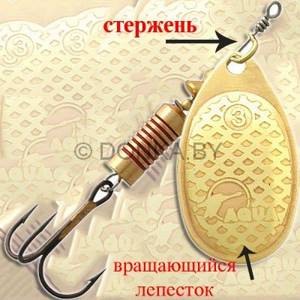
Pinwheel drawing.
Oscillator
An oscillating spoon or, in common parlance, a spoon is also well suited for catching perch. It is advisable to use small micro-oscillators, which have a slightly oblong shape and a “fast” game, which is somewhat similar to the game of a turntable, the only difference is that the bait will rotate around its axis. The weight of such spoons rarely exceeds 7–8 grams, but thanks to their good aerodynamic shape, they cast well, which makes it possible to catch even in the strongest winds.
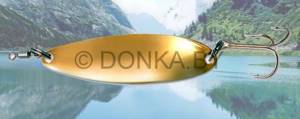
Drawing of an oscillator.
Retractable leash
Fishing with a retractable leash has also recently become very widespread. The essence of this fishing method is that the bait, most often a silicone fish (twister or vibrotail), is attached to a single hook. The role of the load is played by the so-called Cheburashka sinker, which is attached to the main fishing line, while the bait itself is moved 20–30 centimeters to the side. This type of tackle is very suitable for catching perch, since the bait very realistically imitates the behavior of a small wounded fish, literally forcing the perch to attack it. The advantage of this gear is also its versatility - you can easily replace the weight, thereby adapting to changing fishing conditions.

Retractable leash.
In summer, perch can also be caught very successfully using spinning baits such as wobblers and poppers . When choosing them, you must be guided by the same rules as when choosing a spinner and any other lures for catching perch - compact size, light weight and active, pronounced game.
As I already noted, the best time to catch perch in the summer is early in the morning and evening. When you arrive at a pond, first of all, watch its surface; perhaps the perch has already gone hunting and will soon give itself away with the characteristic “smacking” sound that it makes when chasing the fry, quickly opening and closing its mouth. If no traces of the striped robber’s activity are found, then it is necessary to begin an active search for fish. It is best to start by fishing in shallow water areas with a depth of up to one and a half meters; it is advisable that near such places there is small aquatic vegetation, bushes and other obstacles that can serve as an ambush point for perch.
As soon as you catch one “sailor”, with a very high degree of probability we can say that the bites will continue to follow one after another, since perch hunts in schools. I noticed that the largest specimens are immediately caught, then with each trip the size of the caught perch becomes smaller and smaller. This can only be explained by the fact that in a school of perch there is a certain hierarchy, and larger individuals have priority when hunting.
Fishing for pike perch in winter
To catch a trophy specimen, you need to choose the right winter gear and know the behavior of the predator. You also need to have the correct fishing technique.
What baits are used?
- various silicone baits;
- balancers;
- spinners, etc.
There are two ways to catch pike perch:
- girders;
- sheer glitter.
Catching pike perch with a jig in winter
Almost every fisherman has a jig in his arsenal. This is a fairly effective bait, which is used when catching a predator from the ice.
The stores offer a wide range of baits. And you can choose a jig of any color. Jigs are made from various materials. For example, you can use special silicone to make a jig.
So, first let's look at winter gear:
- Fishing line. The fisherman must choose the right fishing line. The line must be strong. Give preference to fishing lines from trusted manufacturers. It is recommended to use a fishing line with a thickness of 0.2–0.3 mm.
- Coil. To unlock its full potential, you need to use a spinning reel.
- Rod. A carbon fiber fishing rod works well. The rod must be durable. If necessary, it must be equipped with a nod.
- Mormyshka. Large jigs are used. The weight of the bait varies from 10 to 30 g.
Pike perch loves careful and smooth play. Fishing should not make unnecessary jerks.
Now let’s look at the jig fishing technique:
- First, the bait sinks to the bottom;
- Now you need to lift the bait (while doing this you need to make smooth swings);
- After this, the jig is lowered to the bottom.
Catching pike perch in winter on Ratlin
Rathlins are super active lures. This wobbler does not have a blade. And the rattle is installed inside the body. There is an attachment point on the back.
Ratlins are popular among both professionals and amateurs. This bait can be used for vertical trolling and ice fishing.
When choosing a bait, you need to pay attention to various parameters (color, weight, size, shape, etc.). And also when choosing ratlins, you need to take into account the fishing conditions (characteristics of the reservoir, weather conditions, time of year, etc.).
Fishermen use various techniques for fishing with ratlin.
Most Popular:
- Combine several different wiring.
- Low frequency game. You can play Ratlin in different horizons. The game should be calm and measured.
- And a sharp rise is also often used. After this, the fisherman resets.
- Often professional fishermen use this technique:
- smooth rise;
- slow descent;
- At the same time, rocking is carried out.
Let's look at the most popular models that you can buy in a fishing store:
- DUO BAY RUF SV;
- Yo-zuri 3D Vibe (suitable for catching large specimens);
- Rapala Rattlin.
What kind of winter gear is used for catching fish in winter on ratlin?
- Rod. Various fishing rods can be used. Experts recommend using American-style rods. The length of such models is 50–70 cm.
- Leash. If necessary, use a strong leash. Sometimes a nod is used.
- Fishing line. Monofilament fishing line is most often used. Give preference to fishing line with a diameter of 0.2–0.3 mm.
- Coil. For fishing at great depths, you need to use an inertial reel.
Catching pike perch in winter using girders
Zherlitsa is a live bait tackle. It is great for catching a variety of fish. There are a large number of designs of winter girders (under the ice, upside-down, on a leg, vertical, horizontal).
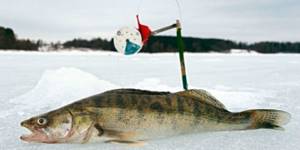
All of them are divided into two types:
- Complex design. This design consists of a special signaling device, a coil and a coil holder.
- Simple design. This design consists of a special bite alarm, a small twig and fishing line.
Winter gear:
- Hook. Most often, single hooks are used.
- Fishing line. The line must be strong. The diameter varies from 0.25 to 0.5 mm. You definitely need to stock up on fishing line.
- Leash.
- Small weight. The weight of the weight is selected individually.
- Bait. Various fish (bleak, roach, etc.) can be used as live bait.
Technique:
- If the fish resists, then you need to pause. In this case, the line must not be loosened.
- The pace of fishing cannot be reduced.
- First, the fishing line is unwound, and then the hooking is performed.
Fishing for pike perch using vibes in winter
Fishing stores offer a wide range of baits. Few fishermen know what vibes are. Vibes are universal baits that are used to catch various predators.
List of the most popular vibe models:
- Usami Vertigo Deep 70s;
- Stike Pro Flap Jack 40;
- Ima Koume 60;
- Saurus Vivra SW 65.
This is not a cheap bait. Many people use it for fishing in the winter season.
Let's consider winter gear:
- reel (often a spinning reel is used);
- vibes;
- fishing rod (choose a strong rod);
- leash.
Now let’s look at the vibration fishing technique. You need to play without pauses. First, active swings are made, and then short ones.
Catching pike perch in winter with foil
Sometimes foil is used as bait. As a rule, it is made by hand. To make foil you will need the following materials: glue, foil, hooks, wire, foam.
First, let's look at the fishing technique:
- First, the bait is lowered to the bottom.
- After this, the foil is lifted in short jerks.
- Now the fisherman must make three turns of the reel.
- The foil sinks to the bottom.
- The actions are repeated.
What does winter gear consist of?
- Fishing rod. A small length fishing rod is used.
- Fishing line. To catch pike perch with foil, use a fishing line with a diameter of 0.3–0.35 mm. You need to wind the reel 20 meters.
- Foil.
- Coil. Any model can be used.
Fishing for pike perch in winter
You can use various baits to catch pike perch. Each bait has its own advantages and disadvantages. To catch pike perch in the winter, you can use a bulldozer.
Balda is a special bait that is used for vertical fishing.
Balda comes in two types:
- pear-shaped;
- elongated.
The weight of such a bait varies from 5 to 20 g. You can make a balda with your own hands or buy it in a specialized store.
Techniques for catching fish on a bulldozer:
- The bait sinks to the bottom;
- After this, you need to adjust the rod;
- The bait needs to be thrown up;
- When lowering the bait to the bottom, you must pause (3-5 seconds).
What does winter gear consist of?
- Various bright beads;
- Hooks. Typically, single hooks are used;
- Weights;
- Fishing line;
- If necessary, use a fishing rod.
Catching pike perch on the current in winter
The best time for fishing is the first ice, as well as the first frosts. Fishing on the current is very specific. First of all, the fisherman must have innovative thinking. And also for successful fishing in the current you will need knowledge and skills.
Advantages of catching pike perch in winter on the current:
- You can use heavy winter gear.
- Mostly large fish are caught.
- You can fish in bad weather conditions (frost, strong wind, etc.).
Disadvantages of catching pike perch in winter on currents:
- Under certain circumstances, the line may overlap.
- In bad weather conditions, the line can get tangled.
- For fishing on the current in winter, you need to use a long fishing line. The length of the fishing line varies from 20 to 30 m.
To catch pike perch in winter on the current, you can use various techniques. The greatest number of bites is observed in the evening and morning hours. And you also need to take weather conditions into account. It is best to go fishing on frosty and sunny days.
Catching pike perch in winter with fry
Pike perch is a cunning predator. It feeds on various fish. Various winter gear is used to catch pike perch.
You can use fry as bait. This is a small fish that has recently hatched.
What types of fry are there?
- bleak;
- gudgeon;
- roach.
Standard winter gear is used, which consists of the following components:
- A fishing rod made of durable materials.
- Fishing line. It is recommended to use fishing line with a diameter of 0.25–0.3 mm.
- Big reel. It is better to choose coils with a diameter of 80 to 100 mm. Give preference to inertial coils.
- If necessary, use a leash.
- Sharp hooks.
This is one of the most exciting and interesting ways of fishing.
Technique for catching pike perch in winter with fry:
- We lower the bait to the bottom;
- We slightly raise the fry;
- Let's pause;
- We carry out the game.
Winter pike perch fishing technique
There are a large number of fishing techniques in winter. Let's look at the most popular techniques:
Fishing technique for pike perch in winter:
- The bait sinks to the bottom.
- The game is being played.
Fishing technique number two:
- The bait goes into free fall. To do this, you need to release the reel brake.
- Now the bait should be dragged along the bottom. To do this, it must be pulled up smoothly.
- Thus, the bait attracts a predator.
Winter fishing technique number three:
- First, the bait must be lowered to the bottom.
- Make a slight rise.
- Pause. Usually the pause lasts 5–6 seconds.
- Now the bait needs to be thrown down sharply.
- Pause.
- Repeat the cycle.
Lures for catching pike perch in winter
To catch pike perch in winter you can use the following baits:
- spoon;
- various silicone baits;
- jigs;
- a piece of fish;
- fry;
- balancers;
- girders;
- ratlin;
- vibes;
- foil;
- idiot.
When choosing bait, you need to consider the following characteristics:
- hook (single, double and triple);
- color (red, blue, bright, etc.);
- weight (give preference to baits whose weight does not exceed 25 grams).
- size;
- manufacturer;
- price.
You can make the bait yourself or purchase it at a fishing store.
Fishing with silicone
Silicone baits are one of the most common. They are shaped like natural fish.
The most popular models of silicone baits:
- DEEP PEARL 100;
- LONG JOHN 07.90/PA03;
- Tioga 100.
Three types of silicone baits:
- slugs;
- vibrotails;
- twisters.
When choosing silicone baits, you need to consider the color, size and type of bait. Today, silicone baits of purple, light green and brown colors are very popular.
You can use the following winter gear:
- spaced winter equipment;
- hinged installation;
- classic option.
A special wiring technique is used. Jerky wiring is most often used.
Let's take a closer look at this fishing technique:
- The silicone bait is lowered to the bottom.
- Periodically you need to raise the bait.
What is the bite like for perch?
The bite of a perch is usually powerful, and the smaller the fish, the more violently it attacks the bait. If you fish with a spinner or spoon equipped with a treble hook, then you don’t even have to hook it - the perch will hook itself, if, of course, the hook of your bait is sharp enough. When fishing with a retractable leash, it is better to make a light hook, as sometimes the fish are not detected. When fishing, you should not rush , especially if there is a perch weighing more than 200 grams on the hook, since with active resistance the fish can simply tear its lips and get off. Perches up to 200 grams in size can be safely taken out of the water on a spinning rod, but with larger specimens you should be careful not to break the light rod. It is better to take the perch by hand, but be very careful not to get hurt on the sharp fin, the wounds from which, by the way, are very painful and do not heal for a long time.
